Non-woven Adhesives Market
Non-woven Adhesives Market Size and Share Forecast Outlook 2025 to 2035
Non-woven adhesives market is projected to grow from USD 3.5 billion in 2025 to USD 8.7 billion by 2035, at a CAGR of 9.6%. Styrenic Block Copolymers (SBC) will dominate with a 48.0% market share, while baby care will lead the application segment with a 42.0% share.
Non-woven Adhesives Market Forecast and Outlook 2025 to 2035
The global non-woven adhesives market is valued at USD 3,478.0 million in 2025 and is set to reach USD 8,689.8 million by 2035, recording an absolute increase of USD 5,211.8 million over the forecast period. This translates into a total growth of 149.9%, with the market forecast to expand at a compound annual growth rate (CAGR) of 9.6% between 2025 and 2035.
The overall market size is expected to grow by approximately 2.5X during the same period, supported by increasing hygiene product consumption, growing demand for disposable nonwoven materials, and rising requirements for efficient bonding solutions across baby care, feminine hygiene, adult incontinence, and medical applications.
Quick Stats for Non-woven Adhesives Market
- Non-woven Adhesives Market Value (2025): USD 3,478.0 million
- Non-woven Adhesives Market Forecast Value (2035): USD 8,689.8 million
- Non-woven Adhesives Market Forecast CAGR: 9.6%
- Leading Type Category in Non-woven Adhesives Market: Styrenic Block Copolymers (SBC) (48.0%)
- Key Growth Regions in Non-woven Adhesives Market: Asia Pacific, Europe, North America
- Key Players in Non-woven Adhesives Market: Adtek Malaysia, Bostik, Cattie Adhesives, Eastman Chemical, Lohmann
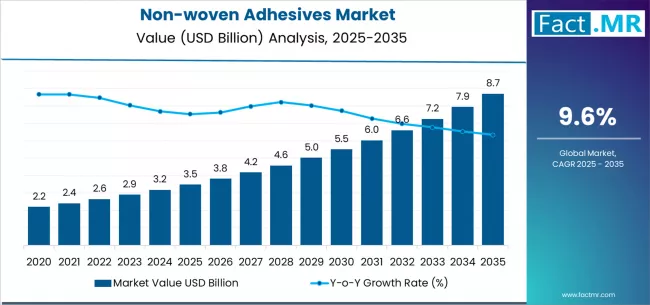
The global non-woven adhesives market represents a critical segment within the hygiene products and nonwoven materials industry, driven by the specialized bonding requirements of disposable applications and the performance characteristics of advanced adhesive formulations. These specialized adhesives provide secure attachment between different nonwoven substrates while maintaining skin-friendly properties, breathability, and comfort during use. The adhesive systems incorporate various polymer technologies including styrenic block copolymers, polyolefins, and pressure-sensitive formulations designed to meet specific application requirements across hygiene, medical, and industrial nonwoven products.
The market encompasses various adhesive technologies, application methods, and specialized formulations tailored for specific end-use applications. Modern non-woven adhesives incorporate advanced polymer chemistry, improved heat resistance, and enhanced bonding characteristics that can maintain performance across diverse substrate combinations and processing conditions. The integration of sustainable polymer platforms, reduced volatile organic compound emissions, and bio-based raw material content has further enhanced the value proposition of these adhesive systems among manufacturers seeking environmental compliance and operational efficiency.
Market dynamics are significantly influenced by stringent hygiene product regulations, particularly in baby care and medical applications where skin compatibility, chemical safety, and material purity are paramount. The hygiene products sector's increasing focus on product performance, user comfort, and manufacturing efficiency has created substantial demand for high-performance adhesive solutions in diaper construction, feminine hygiene products, and adult incontinence systems. The growing trend toward premium hygiene products and advanced nonwoven materials has amplified the need for specialized adhesive systems capable of supporting complex product designs and enhanced user experience.
Consumer purchasing patterns show a marked preference for hygiene products that combine superior comfort with reliable performance, driving demand for adhesive systems that support elastic attachment, wetness barriers, and breathable construction in disposable products. The market has witnessed significant technological advancement in polymer modification, application equipment design, and process optimization systems, making these adhesives more suitable for high-speed manufacturing, reduced energy consumption, and improved product consistency.
Between 2025 and 2030, the market is projected to expand from USD 3,478.0 million to USD 5,486.7 million, resulting in a value increase of USD 2,008.7 million, which represents 38.5% of the total forecast growth for the decade. This phase of development will be shaped by increasing hygiene product consumption in emerging markets, rising demand for premium disposable products, and growing availability of advanced polymer technologies across manufacturing facilities and product development applications.
Between 2030 and 2035, the market is forecast to grow from USD 5,486.7 million to USD 8,689.8 million, adding another USD 3,203.1 million, which constitutes 61.5% of the overall ten-year expansion. This period is expected to be characterized by the advancement of bio-based adhesive formulations, the development of high-performance polymer systems for demanding applications, and the expansion of automated application technologies across diverse hygiene and medical product manufacturing. The growing focus on circular economy principles and advanced material science will drive demand for innovative adhesive varieties with enhanced recyclability, improved performance characteristics, and superior processing efficiency profiles.
Between 2020 and 2024, the market experienced accelerated growth, driven by increasing global hygiene awareness and growing recognition of advanced adhesive technologies' role in product performance following extensive industry adoption of next-generation polymer platforms. The market developed as manufacturers recognized the advantages of specialized nonwoven adhesives over conventional bonding methods in hygiene applications and began seeking advanced solutions designed for high-speed production requirements. Technological advancement in polymer chemistry and application systems began focusing the critical importance of maintaining bonding strength while enhancing processing efficiency and improving end-product performance across diverse hygiene and medical applications.
Non-woven Adhesives Market Key Takeaways
| Metric | Value |
|---|---|
| Estimated Value in (2025E) | USD 3,478.0 million |
| Forecast Value in (2035F) | USD 8,689.8 million |
| Forecast CAGR (2025 to 2035) | 9.6% |
From 2030 to 2035, the market is forecast to grow from USD 5,486.7 million to USD 8,689.8 million, adding another USD 3,203.1 million, which constitutes 61.5% of the overall ten-year expansion. This period is expected to be characterized by the advancement of smart adhesive technologies with responsive properties, the integration of digital monitoring systems for quality control, and the development of specialized formulations for next-generation hygiene products. The growing focus on product innovation and manufacturing excellence will drive demand for premium varieties with enhanced polymer performance capabilities, improved application characteristics, and superior end-product integration features.
Between 2020 and 2024, the market experienced robust growth, driven by increasing awareness of hygiene product quality and growing recognition of specialized adhesive systems' effectiveness in supporting reliable product performance across baby care, feminine hygiene, and adult incontinence applications. The market developed as users recognized the potential for advanced nonwoven adhesives to deliver manufacturing advantages while meeting modern requirements for product comfort and processing efficiency. Technological advancement in polymer design and application technology began focusing the critical importance of maintaining adhesive performance while extending product durability and improving user satisfaction across diverse hygiene product applications.
Why is the Non-Woven Adhesives Market Growing?
Market expansion is being supported by the increasing global focus on hygiene product quality and the corresponding shift toward high-performance adhesive systems that can provide superior bonding characteristics while meeting user requirements for comfort and cost-effective manufacturing solutions. Modern hygiene product manufacturers are increasingly focused on incorporating adhesive systems that can enhance product reliability while satisfying demands for consistent, precisely controlled bonding performance and optimized production efficiency practices. Non-woven adhesives' proven ability to deliver polymer chemistry excellence, processing advantages, and diverse application possibilities makes them essential components for quality-focused manufacturers and performance-oriented product developers.
The growing focus on product innovation and manufacturing optimization is driving demand for high-performance adhesive systems that can support distinctive product outcomes and comprehensive bonding management across hygiene product manufacturing, medical device assembly, and premium nonwoven applications. User preference for adhesive solutions that combine functional excellence with processing efficiency is creating opportunities for innovative implementations in both traditional and emerging hygiene product applications. The rising influence of automation technologies and advanced manufacturing systems is also contributing to increased adoption of specialized adhesive solutions that can provide authentic performance benefits and reliable processing characteristics.
Segmental Analysis
What factors enable the styrenic block copolymers (SBC) type, baby care application, and hot-melt technology segments to lead market share and demonstrate strong dominance?
The market is segmented by type, application, technology, end-user, and region. By type, the market is divided into styrenic block copolymers (SBC), polyolefins, ethylene vinyl acetate (EVA), and other polymer types. Based on application, the market is categorized into baby care, feminine hygiene, adult incontinence, medical, and others. By technology, the market includes hot-melt, solvent-based, and water-based categories. By end-user, the market encompasses hygiene products manufacturers, medical device companies, and industrial applications. Regionally, the market is divided into North America, Europe, Asia Pacific, Latin America, Middle East & Africa, and other regions.
By Type, the Styrenic Block Copolymers (SBC) Segment Accounts for 48.0% Market Share
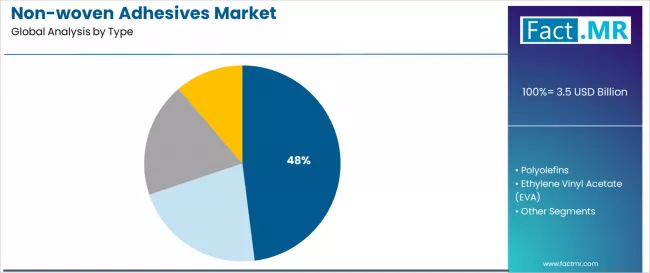
The styrenic block copolymers (SBC) segment is projected to account for 48.0% of the market in 2025, reaffirming its position as the leading type category. Hygiene product manufacturers and adhesive formulators increasingly utilize SBC systems for their superior elasticity characteristics, established processing performance, and essential functionality in diverse bonding applications across multiple hygiene product categories. SBC adhesives' proven performance characteristics and established cost-effectiveness directly address user requirements for reliable substrate bonding and optimal operational precision in high-speed manufacturing and product assembly applications.
This type segment forms the foundation of modern hygiene product performance patterns, as it represents the polymer technology with the greatest application versatility and established compatibility across multiple nonwoven substrate combinations. Manufacturing investments in advanced polymer modification and performance optimization continue to strengthen adoption among quality-focused users. With manufacturers prioritizing processing consistency and bonding reliability, SBC systems align with both efficiency objectives and performance requirements, making them the central component of comprehensive adhesive strategies.
By Application, Baby Care Segment Shows Strong Market Dominance
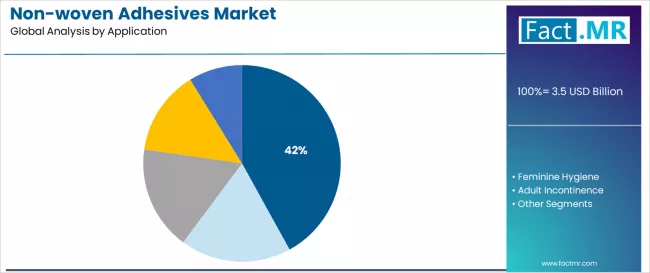
Baby care is projected to represent 42.0% of the non-woven adhesives market in 2025, highlighting its critical role as the primary application for comfort-focused users seeking superior bonding benefits and enhanced product performance credentials. Baby care manufacturers and product developers prefer baby care applications for their established quality requirements, proven performance demand, and ability to maintain exceptional comfort characteristics while supporting versatile product design during diverse manufacturing activities. Positioned as essential applications for quality-focused manufacturers, baby care offerings provide both performance excellence and user satisfaction advantages.
The segment is supported by continuous improvement in product technology and the widespread availability of established safety standards that enable performance assurance and premium positioning at the manufacturing level. Baby care users are optimizing adhesive selections to support product-specific applications and comprehensive comfort strategies. As hygiene product technology continues to advance and manufacturers seek efficient bonding methods, baby care applications will continue to drive market growth while supporting product innovation and user satisfaction strategies.
By Technology, Hot-melt Segment Demonstrates Leading Position
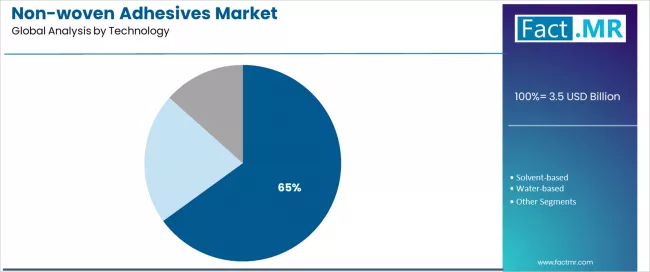
Hot-melt technology is projected to represent 65.0% of the non-woven adhesives market in 2025, establishing its position as the dominant technology category. Manufacturing facilities and adhesive processors increasingly utilize hot-melt systems for their superior processing efficiency, established application characteristics, and essential functionality in high-speed production environments across multiple hygiene product manufacturing operations. Hot-melt technology's proven processing advantages and established operational effectiveness directly address manufacturing requirements for reliable application performance and optimal production efficiency in automated assembly and continuous processing applications.
The segment benefits from ongoing advancement in application equipment design and the widespread availability of specialized processing systems that enable consistent performance and efficient operation at the production level. Manufacturing facilities continue to optimize hot-melt selections to support speed-specific applications and comprehensive production strategies. As manufacturing automation continues to advance and processors seek efficient application methods, hot-melt technology will maintain its market leadership while supporting operational efficiency and production optimization strategies.
What are the Drivers, Restraints, and Key Trends of the Non-Woven Adhesives Market?
The non-woven adhesives market is advancing rapidly due to increasing hygiene product consumption and growing need for high-performance bonding solutions that emphasize superior polymer chemistry across hygiene segments and nonwoven applications. The market faces challenges, including raw material price volatility, processing complexity considerations, and regulatory compliance factors affecting adoption rates. Innovation in polymer technology enhancement and advanced application methods continues to influence market development and expansion patterns.
Expansion of Premium Hygiene Products and Advanced Materials
The growing adoption of non-woven adhesives with enhanced performance characteristics and premium product integration is enabling users to develop hygiene products that provide distinctive comfort benefits while commanding superior bonding reliability and enhanced user experience characteristics. Premium hygiene applications provide superior product consistency while allowing more sophisticated design features across various hygiene product categories. Users are increasingly recognizing the performance advantages of specialized adhesive positioning for comprehensive product development outcomes and quality-integrated manufacturing management.
Integration of Bio-based Polymers and Environmental Compliance Systems
Modern non-woven adhesive manufacturers are incorporating bio-based polymer content, renewable raw material sources, and environmental compliance systems to enhance processing precision, improve product profile effectiveness, and meet industry demands for environmentally conscious bonding solutions. These systems improve manufacturing effectiveness while enabling new applications, including circular economy programs and advanced recycling protocols. Environmental compliance integration also allows users to support regulatory positioning and performance assurance beyond traditional adhesive operation requirements.
Analysis of the Non-Woven Adhesives Market by Key Country
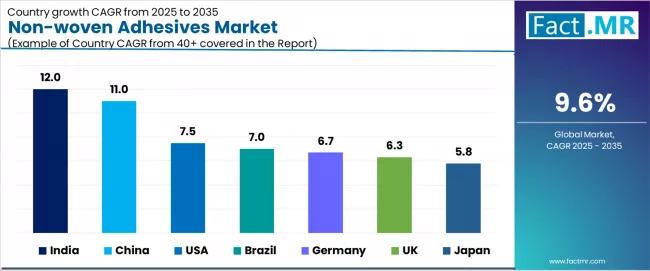
| Country | CAGR (2025-2035) |
|---|---|
| China | 11.0% |
| India | 12.0% |
| Germany | 6.7% |
| Brazil | 7.0% |
| USA | 7.5% |
| UK | 6.3% |
| Japan | 5.8% |
The market is experiencing robust growth globally, with India leading at a 12.0% CAGR through 2035, driven by the expanding hygiene products sector, growing population demographics, and increasing adoption of disposable hygiene products. China follows at 11.0%, supported by rising manufacturing capabilities, expanding consumer market, and growing acceptance of premium hygiene products. USA shows growth at 7.5%, focusing established hygiene product standards and comprehensive manufacturing development. Brazil records 7.0%, focusing on market modernization and hygiene product accessibility growth. Germany demonstrates 6.7% growth, prioritizing advanced manufacturing technologies and quality optimization.
The report covers an in-depth analysis of 40+ countries, top-performing countries are highlighted below.
Why does India lead global market growth through its demographic advantage?
India is projected to exhibit exceptional growth with a CAGR of 12.0% through 2035, driven by the country's rapidly expanding population, favorable demographic trends toward hygiene product adoption, and initiatives promoting modern hygiene practices across major population centers. India's position as a growing consumer market and increasing focus on hygiene product accessibility are creating substantial demand for cost-effective nonwoven adhesives in both domestic consumption and manufacturing applications. Major hygiene product companies and adhesive distributors are establishing comprehensive manufacturing capabilities to serve growing demand and emerging market opportunities.
- Expanding population base and growing hygiene consciousness are driving demand for non-woven adhesives across baby care products, feminine hygiene applications, and comprehensive hygiene product systems throughout Indian consumer markets.
- Strong demographic trends and hygiene adoption initiatives are supporting the rapid adoption of affordable adhesive systems among manufacturers seeking to meet evolving consumer standards and accessibility requirements.
How does China demonstrate strong market potential through manufacturing leadership?
China is expanding at a CAGR of 11.0%, supported by rising manufacturing investment, growing consumer consciousness, and expanding production capabilities. The country's developing consumer market and increasing investment in hygiene product technologies are driving demand for adhesive systems across both traditional and modern hygiene applications. International adhesive companies and domestic manufacturers are establishing comprehensive operational networks to address growing market demand for bonding solutions and efficient manufacturing technologies.
- Rising consumer development and expanding manufacturing capabilities are creating opportunities for non-woven adhesive adoption across hygiene industries, modern production facilities, and manufacturing companies throughout major Chinese industrial regions.
- Growing consumer awareness initiatives and adhesive technology advancement are driving the adoption of specialized bonding products and services among manufacturers seeking to enhance their production efficiency and meet increasing consumer demand.
How does the USA maintain market leadership through technology excellence?
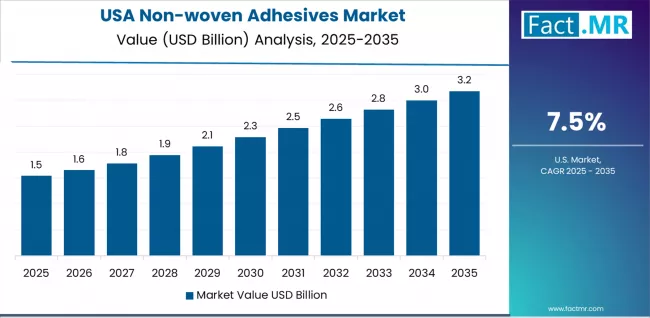
The USA is projected to grow at a CAGR of 7.5% through 2035, supported by the country's mature hygiene product standards, established manufacturing regulations, and leadership in adhesive technology development. The USA's sophisticated product standards and strong support for advanced manufacturing systems are creating steady demand for both traditional and innovative adhesive varieties. Leading hygiene product manufacturers and specialty formulators are establishing comprehensive operational strategies to serve both domestic markets and growing export opportunities.
- Advanced manufacturing technology capabilities and established quality-focused markets are driving demand for premium non-woven adhesives across hygiene facilities, production plants, and comprehensive manufacturing companies seeking superior performance profiles and technology innovation.
- Strong quality excellence culture and regulatory leadership are supporting the adoption of innovative adhesive technology among users prioritizing product reliability and manufacturing precision in hygiene product applications.
How does Brazil strengthen its position through market expansion growth?
Brazil is projected to grow at a CAGR of 7.0% through 2035, driven by the country's focus on hygiene product development, market accessibility growth, and growing manufacturing capabilities. Brazilian hygiene product users and manufacturing facilities consistently seek quality-focused products that enhance user experience and support accessibility excellence for both traditional and modern hygiene applications. The country's position as a Latin American market leader continues to drive innovation in specialized bonding applications and hygiene product standards.
- Expanding consumer culture and growing hygiene markets are driving demand for industrial non-woven adhesives across manufacturing consumers, hygiene providers, and accessibility-focused distributors seeking superior bonding performance and distinctive product profiles.
- Increasing focus on product accessibility and market expansion systems is supporting the adoption of specialty adhesive varieties among users and distributors seeking authentic Brazilian quality-focused products in regional markets with established manufacturing expertise.
How does Germany anchor market growth through engineering integration?
Germany is projected to grow at a CAGR of 6.7% through 2035, supported by the country's focus on manufacturing technology advancement, product quality optimization, and advanced processing system integration requiring efficient bonding solutions. German hygiene product users and manufacturing-focused facilities prioritize performance reliability and processing precision, making specialized non-woven adhesives essential components for both traditional and modern hygiene product manufacturing applications. The country's comprehensive manufacturing technology leadership and advancing quality patterns support continued market expansion.
- Advanced manufacturing technology capabilities and growing precision processing management are driving demand for non-woven adhesives across specialty applications, modern production formats, and technology-integrated manufacturing programs serving domestic markets with increasing quality requirements.
- Strong focus on processing optimization and performance excellence is encouraging users and distributors to adopt adhesive solutions that support efficiency objectives and meet German quality standards for hygiene product manufacturing applications.
How does the UK maintain steady growth through a focus on quality and reliability?
The UK is projected to grow at a CAGR of 6.3% through 2035, supported by established product standards, mature hygiene markets, and focus on quality reliability across manufacturing and consumer sectors. British hygiene product users and manufacturing professionals prioritize consistent performance and operational reliability, creating steady demand for premium adhesive solutions. The country's comprehensive market maturity and established manufacturing practices support continued development in specialized applications.
- Established hygiene markets and mature manufacturing industry are driving demand for quality non-woven adhesives across production operations, hygiene facilities, and professional manufacturing companies throughout British industrial regions.
- Strong focus on quality standards and operational reliability is supporting the adoption of premium adhesive varieties among users seeking proven performance and established manufacturing credentials in hygiene applications.
How does Japan demonstrate growth through a focus on quality?
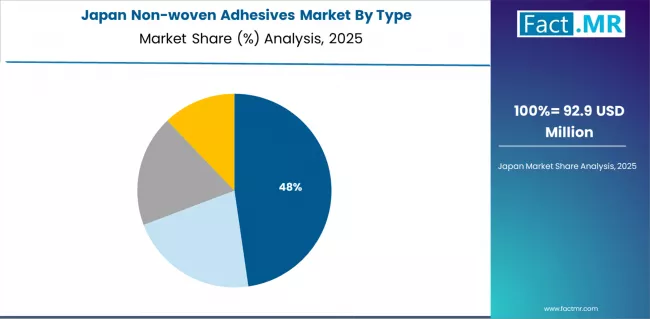
Japan is projected to grow at a CAGR of 5.8% through 2035, supported by the country's focus on quality manufacturing, operational excellence, and advanced technology integration requiring efficient bonding solutions. Japanese hygiene product users and quality-focused facilities prioritize technical performance and manufacturing precision, making specialized non-woven adhesives essential components for both traditional and modern hygiene product manufacturing applications. The country's comprehensive manufacturing leadership and advancing quality patterns support continued market expansion.
- Advanced quality manufacturing technology capabilities and growing technical hygiene applications are driving demand for non-woven adhesives across specialty product applications, modern quality formats, and technology-integrated manufacturing programs serving domestic markets with increasing precision requirements.
- Strong focus on technical quality and operational excellence is encouraging users and distributors to adopt adhesive solutions that support manufacturing objectives and meet Japanese quality standards for hygiene product applications.
Europe Market Split by Country
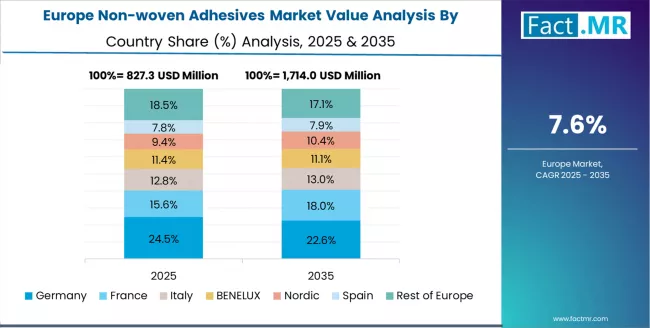
The Europe non-woven adhesives market is projected to grow from USD 982.4 million in 2025 to USD 2,195.6 million by 2035, recording a CAGR of 8.4% over the forecast period. Germany leads the region with a 39.2% share in 2025, moderating slightly to 38.7% by 2035, supported by its strong manufacturing traditions and demand for premium, high-performance adhesive solutions. The United Kingdom follows with 19.8% in 2025, easing to 19.4% by 2035, driven by a mature hygiene products market and focus on quality reliability and manufacturing precision. France accounts for 16.3% in 2025, rising to 16.8% by 2035, reflecting steady adoption of advanced adhesive technologies and product innovation. Italy holds 11.7% in 2025, expanding to 12.3% by 2035 as hygiene product modernization and specialty manufacturing applications grow. Spain contributes 7.2% in 2025, growing to 7.6% by 2035, supported by expanding consumer market development and manufacturing modernization. The Nordic countries rise from 3.9% in 2025 to 4.1% by 2035 on the back of strong quality consciousness and advanced manufacturing methodologies. BENELUX remains at 1.9% share across both 2025 and 2035, reflecting mature, quality-focused hygiene product markets.
How is the competitive landscape of the non-woven adhesives market structured and what key factors influence competition?
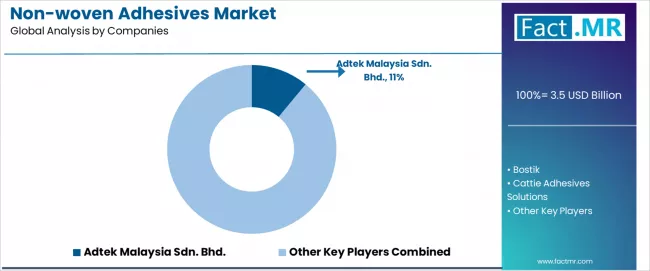
The market is characterized by competition among established chemical companies, specialized adhesive manufacturers, and integrated polymer solution providers. Companies are investing in advanced polymer technologies, specialized formulation capabilities, product innovation systems, and comprehensive distribution networks to deliver consistent, high-quality, and reliable adhesive solutions. Innovation in polymer chemistry optimization, application technology advancement, and hygiene-focused product development is central to strengthening market position and customer satisfaction.
Adtek Malaysia leads the market with a strong focus on adhesive technology innovation and comprehensive bonding solutions, offering hygiene and industrial systems with focus on performance excellence and manufacturing heritage. Bostik provides integrated adhesive systems with a focus on hygiene market applications and precision bonding networks. Cattie Adhesives delivers comprehensive adhesive technology solutions with a focus on industrial positioning and operational efficiency. Eastman Chemical specializes in comprehensive polymer systems with an focus on hygiene applications. Lohmann focuses on comprehensive bonding solutions with advanced design and premium positioning capabilities.
Global Non-Woven Adhesives Market - Stakeholder Contribution Framework
The success of non-woven adhesives in meeting hygiene product demands, manufacturing efficiency requirements, and quality integration will not only enhance hygiene product performance outcomes but also strengthen global adhesive technology manufacturing capabilities. It will consolidate emerging regions' positions as hubs for efficient adhesive production and align advanced economies with comprehensive hygiene systems. This calls for a concerted effort by all stakeholders - governments, industry bodies, manufacturers, distributors, and investors. Each can be a crucial enabler in preparing the market for its next phase of growth.
How Governments Could Spur Local Production and Adoption?
- Targeted Incentives: Introduce hygiene product manufacturing subsidies for companies adopting advanced adhesive production technologies in manufacturing and processing regions, and production-linked incentives for facilities producing materials for domestic consumption and export markets.
- Trade Agreements: Accelerate export growth through bilateral and multilateral agreements that classify non-woven adhesives under "hygiene manufacturing materials," easing cross-border regulatory approvals and product safety certifications.
- Facilitate Innovation: Establish Centers of Excellence for adhesive technology innovation and polymer engineering. Fund R&D into efficient bonding systems, material optimization, and hygiene-standard integration for manufacturing and consumer applications.
How Industry Bodies Could Support Market Development?
- Foster Connectivity: Constitute a global adhesive technology consortium linking adhesive manufacturers, hygiene product suppliers, users, and policymakers to align production targets with hygiene accessibility and quality commitments.
- Promote Exports: Work with export councils to brand non-woven adhesives as premium, quality-focused hygiene solutions. Facilitate trade fairs to connect adhesive technology innovators with global buyers in hygiene, medical, and consumer sectors.
- Upskilling Programs: Develop curricula on advanced adhesive manufacturing, polymer technology, hygiene product processes, and quality optimization to prepare manufacturers and operators for premium hygiene market opportunities.
How Distributors and Hygiene Product Players Could Strengthen the Ecosystem?
- Drive Integration: Bundle non-woven adhesives with hygiene-focused marketing and quality messaging systems. Position specialized adhesives as part of holistic "hygiene product optimization solutions."
- Forge Partnerships: Collaborate with adhesive manufacturers and technology providers for joint R&D on hygiene applications, quality enhancement initiatives, and global performance assurance for premium markets.
How Manufacturers Could Navigate the Shift?
- Capture Premium Markets: Leverage government incentives and rising hygiene demand to offer non-woven adhesives into growth markets where general bonding solutions face performance and reliability challenges.
- Invest in Technology: Partner with technology providers to advance efficient polymer workflows, hygiene-grade quality, and advanced manufacturing practices.
- Build Capabilities: Train technical staff and hygiene specialists to demonstrate adhesives' operational advantages, repositioning manufacturing relationships toward long-term hygiene partnerships.
Key Players in the Non-Woven Adhesives Market
- Adtek Malaysia Sdn. Bhd.
- Bostik
- Cattie Adhesives Solutions
- Eastman Chemical
- Lohmann-koester GmbH Co.
- Michelman
- PAM Fastening Technology
- Sika Ireland
- Henkel
- 3M
- H.B. Fuller
- Arkema
- Dow Chemical
- Avery Dennison
- Beardow Adams
- Collano
- Evans Adhesive
- Findley Adhesives
- Jowat
- Tex Year Industries
- Palmetto Adhesives
- Rayven
Scope of the Report
| Items | Values |
|---|---|
| Quantitative Units (2025) | USD 3,478.0 million |
| Type | Styrenic Block Copolymers (SBC), Polyolefins, Ethylene Vinyl Acetate (EVA), Others |
| Application | Baby Care, Feminine Hygiene, Adult Incontinence, Medical, Others |
| Technology | Hot-melt, Solvent-based, Water-based |
| End-User | Hygiene Products Manufacturers, Medical Device Companies, Industrial Applications |
| Regions Covered | North America, Europe, Asia Pacific, Latin America, Middle East & Africa, Other Regions |
| Countries Covered | China, India, Germany, Brazil, United States, United Kingdom, Japan, and 40+ countries |
| Key Companies Profiled | Adtek Malaysia, Bostik, Cattie Adhesives, Eastman Chemical, Lohmann, and other leading non-woven adhesive companies |
| Additional Attributes | Dollar sales by type, application, technology, end-user, and region; regional demand trends, competitive landscape, technological advancements in polymer engineering, adhesive optimization initiatives, manufacturing enhancement programs, and premium product development strategies |
Non-woven Adhesives Market by Segments
-
Type :
- Styrenic Block Copolymers (SBC)
- Polyolefins
- Ethylene Vinyl Acetate (EVA)
- Others
-
Application :
- Baby Care
- Feminine Hygiene
- Adult Incontinence
- Medical
- Others
-
Technology :
- Hot-melt
- Solvent-based
- Water-based
-
End-User :
- Hygiene Products Manufacturers
- Medical Device Companies
- Industrial Applications
-
Region :
- North America
- United States
- Canada
- Mexico
- Europe
- Germany
- United Kingdom
- France
- Italy
- Spain
- Nordic Countries
- BENELUX
- Rest of Europe
- Asia Pacific
- China
- India
- Japan
- South Korea
- Australia
- Rest of Asia Pacific
- Latin America
- Brazil
- Argentina
- Rest of Latin America
- Middle East & Africa
- Kingdom of Saudi Arabia
- United Arab Emirates
- South Africa
- Rest of Middle East & Africa
- Other Regions
- Oceania
- Central Asia
- Other Markets
- North America
Table of Content
- Executive Summary
- Global Market Outlook
- Demand to side Trends
- Supply to side Trends
- Technology Roadmap Analysis
- Analysis and Recommendations
- Market Overview
- Market Coverage / Taxonomy
- Market Definition / Scope / Limitations
- Market Background
- Market Dynamics
- Drivers
- Restraints
- Opportunity
- Trends
- Scenario Forecast
- Demand in Optimistic Scenario
- Demand in Likely Scenario
- Demand in Conservative Scenario
- Opportunity Map Analysis
- Product Life Cycle Analysis
- Supply Chain Analysis
- Investment Feasibility Matrix
- Value Chain Analysis
- PESTLE and Porter’s Analysis
- Regulatory Landscape
- Regional Parent Market Outlook
- Production and Consumption Statistics
- Import and Export Statistics
- Market Dynamics
- Global Market Analysis 2020 to 2024 and Forecast, 2025 to 2035
- Historical Market Size Value (USD Million) Analysis, 2020 to 2024
- Current and Future Market Size Value (USD Million) Projections, 2025 to 2035
- Y to o to Y Growth Trend Analysis
- Absolute $ Opportunity Analysis
- Global Market Pricing Analysis 2020 to 2024 and Forecast 2025 to 2035
- Global Market Analysis 2020 to 2024 and Forecast 2025 to 2035, By Type
- Introduction / Key Findings
- Historical Market Size Value (USD Million) Analysis By Type , 2020 to 2024
- Current and Future Market Size Value (USD Million) Analysis and Forecast By Type , 2025 to 2035
- Styrenic Block Copolymers (SBC)
- Polyolefins
- Ethylene Vinyl Acetate (EVA)
- Others
- Y to o to Y Growth Trend Analysis By Type , 2020 to 2024
- Absolute $ Opportunity Analysis By Type , 2025 to 2035
- Global Market Analysis 2020 to 2024 and Forecast 2025 to 2035, By Application
- Introduction / Key Findings
- Historical Market Size Value (USD Million) Analysis By Application, 2020 to 2024
- Current and Future Market Size Value (USD Million) Analysis and Forecast By Application, 2025 to 2035
- Baby Care
- Feminine Hygiene
- Adult Incontinence
- Medical
- Others
- Y to o to Y Growth Trend Analysis By Application, 2020 to 2024
- Absolute $ Opportunity Analysis By Application, 2025 to 2035
- Global Market Analysis 2020 to 2024 and Forecast 2025 to 2035, By Technology
- Introduction / Key Findings
- Historical Market Size Value (USD Million) Analysis By Technology, 2020 to 2024
- Current and Future Market Size Value (USD Million) Analysis and Forecast By Technology, 2025 to 2035
- Hot-melt
- Solvent-based
- Water-based
- Y to o to Y Growth Trend Analysis By Technology, 2020 to 2024
- Absolute $ Opportunity Analysis By Technology, 2025 to 2035
- Global Market Analysis 2020 to 2024 and Forecast 2025 to 2035, By Region
- Introduction
- Historical Market Size Value (USD Million) Analysis By Region, 2020 to 2024
- Current Market Size Value (USD Million) Analysis and Forecast By Region, 2025 to 2035
- North America
- Latin America
- Western Europe
- Eastern Europe
- East Asia
- South Asia and Pacific
- Middle East & Africa
- Market Attractiveness Analysis By Region
- North America Market Analysis 2020 to 2024 and Forecast 2025 to 2035, By Country
- Historical Market Size Value (USD Million) Trend Analysis By Market Taxonomy, 2020 to 2024
- Market Size Value (USD Million) Forecast By Market Taxonomy, 2025 to 2035
- By Country
- USA
- Canada
- Mexico
- By Type
- By Application
- By Technology
- By Country
- Market Attractiveness Analysis
- By Country
- By Type
- By Application
- By Technology
- Key Takeaways
- Latin America Market Analysis 2020 to 2024 and Forecast 2025 to 2035, By Country
- Historical Market Size Value (USD Million) Trend Analysis By Market Taxonomy, 2020 to 2024
- Market Size Value (USD Million) Forecast By Market Taxonomy, 2025 to 2035
- By Country
- Brazil
- Chile
- Rest of Latin America
- By Type
- By Application
- By Technology
- By Country
- Market Attractiveness Analysis
- By Country
- By Type
- By Application
- By Technology
- Key Takeaways
- Western Europe Market Analysis 2020 to 2024 and Forecast 2025 to 2035, By Country
- Historical Market Size Value (USD Million) Trend Analysis By Market Taxonomy, 2020 to 2024
- Market Size Value (USD Million) Forecast By Market Taxonomy, 2025 to 2035
- By Country
- Germany
- UK
- Italy
- Spain
- France
- Nordic
- BENELUX
- Rest of Western Europe
- By Type
- By Application
- By Technology
- By Country
- Market Attractiveness Analysis
- By Country
- By Type
- By Application
- By Technology
- Key Takeaways
- Eastern Europe Market Analysis 2020 to 2024 and Forecast 2025 to 2035, By Country
- Historical Market Size Value (USD Million) Trend Analysis By Market Taxonomy, 2020 to 2024
- Market Size Value (USD Million) Forecast By Market Taxonomy, 2025 to 2035
- By Country
- Russia
- Poland
- Hungary
- Balkan & Baltic
- Rest of Eastern Europe
- By Type
- By Application
- By Technology
- By Country
- Market Attractiveness Analysis
- By Country
- By Type
- By Application
- By Technology
- Key Takeaways
- East Asia Market Analysis 2020 to 2024 and Forecast 2025 to 2035, By Country
- Historical Market Size Value (USD Million) Trend Analysis By Market Taxonomy, 2020 to 2024
- Market Size Value (USD Million) Forecast By Market Taxonomy, 2025 to 2035
- By Country
- China
- Japan
- South Korea
- By Type
- By Application
- By Technology
- By Country
- Market Attractiveness Analysis
- By Country
- By Type
- By Application
- By Technology
- Key Takeaways
- South Asia and Pacific Market Analysis 2020 to 2024 and Forecast 2025 to 2035, By Country
- Historical Market Size Value (USD Million) Trend Analysis By Market Taxonomy, 2020 to 2024
- Market Size Value (USD Million) Forecast By Market Taxonomy, 2025 to 2035
- By Country
- India
- ASEAN
- Australia & New Zealand
- Rest of South Asia and Pacific
- By Type
- By Application
- By Technology
- By Country
- Market Attractiveness Analysis
- By Country
- By Type
- By Application
- By Technology
- Key Takeaways
- Middle East & Africa Market Analysis 2020 to 2024 and Forecast 2025 to 2035, By Country
- Historical Market Size Value (USD Million) Trend Analysis By Market Taxonomy, 2020 to 2024
- Market Size Value (USD Million) Forecast By Market Taxonomy, 2025 to 2035
- By Country
- Kingdom of Saudi Arabia
- Other GCC Countries
- Turkiye
- South Africa
- Other African Union
- Rest of Middle East & Africa
- By Type
- By Application
- By Technology
- By Country
- Market Attractiveness Analysis
- By Country
- By Type
- By Application
- By Technology
- Key Takeaways
- Key Countries Market Analysis
- USA
- Pricing Analysis
- Market Share Analysis, 2024
- By Type
- By Application
- By Technology
- Canada
- Pricing Analysis
- Market Share Analysis, 2024
- By Type
- By Application
- By Technology
- Mexico
- Pricing Analysis
- Market Share Analysis, 2024
- By Type
- By Application
- By Technology
- Brazil
- Pricing Analysis
- Market Share Analysis, 2024
- By Type
- By Application
- By Technology
- Chile
- Pricing Analysis
- Market Share Analysis, 2024
- By Type
- By Application
- By Technology
- Germany
- Pricing Analysis
- Market Share Analysis, 2024
- By Type
- By Application
- By Technology
- UK
- Pricing Analysis
- Market Share Analysis, 2024
- By Type
- By Application
- By Technology
- Italy
- Pricing Analysis
- Market Share Analysis, 2024
- By Type
- By Application
- By Technology
- Spain
- Pricing Analysis
- Market Share Analysis, 2024
- By Type
- By Application
- By Technology
- France
- Pricing Analysis
- Market Share Analysis, 2024
- By Type
- By Application
- By Technology
- India
- Pricing Analysis
- Market Share Analysis, 2024
- By Type
- By Application
- By Technology
- ASEAN
- Pricing Analysis
- Market Share Analysis, 2024
- By Type
- By Application
- By Technology
- Australia & New Zealand
- Pricing Analysis
- Market Share Analysis, 2024
- By Type
- By Application
- By Technology
- China
- Pricing Analysis
- Market Share Analysis, 2024
- By Type
- By Application
- By Technology
- Japan
- Pricing Analysis
- Market Share Analysis, 2024
- By Type
- By Application
- By Technology
- South Korea
- Pricing Analysis
- Market Share Analysis, 2024
- By Type
- By Application
- By Technology
- Russia
- Pricing Analysis
- Market Share Analysis, 2024
- By Type
- By Application
- By Technology
- Poland
- Pricing Analysis
- Market Share Analysis, 2024
- By Type
- By Application
- By Technology
- Hungary
- Pricing Analysis
- Market Share Analysis, 2024
- By Type
- By Application
- By Technology
- Kingdom of Saudi Arabia
- Pricing Analysis
- Market Share Analysis, 2024
- By Type
- By Application
- By Technology
- Turkiye
- Pricing Analysis
- Market Share Analysis, 2024
- By Type
- By Application
- By Technology
- South Africa
- Pricing Analysis
- Market Share Analysis, 2024
- By Type
- By Application
- By Technology
- USA
- Market Structure Analysis
- Competition Dashboard
- Competition Benchmarking
- Market Share Analysis of Top Players
- By Regional
- By Type
- By Application
- By Technology
- Competition Analysis
- Competition Deep Dive
- Adtek Malaysia Sdn. Bhd.
- Overview
- Product Portfolio
- Profitability by Market Segments (Product/Age /Sales Channel/Region)
- Sales Footprint
- Strategy Overview
- Marketing Strategy
- Product Strategy
- Channel Strategy
- Bostik
- Cattie Adhesives Solutions
- Eastman Chemical
- Lohmann-koester GmbH Co.
- Michelman
- PAM Fastening Technology
- Sika Ireland
- Henkel
- 3M
- H.B. Fuller
- Arkema
- Dow Chemical
- Avery Dennison
- Beardow Adams
- Collano
- Evans Adhesive
- Findley Adhesives
- Jowat
- Tex Year Industries
- Adtek Malaysia Sdn. Bhd.
- Competition Deep Dive
- Assumptions & Acronyms Used
- Research Methodology
List Of Table
- Table 1: Global Market Value (USD Million) Forecast by Region, 2020 to 2035
- Table 2: Global Market Value (USD Million) Forecast by Type , 2020 to 2035
- Table 3: Global Market Value (USD Million) Forecast by Application, 2020 to 2035
- Table 4: Global Market Value (USD Million) Forecast by Technology, 2020 to 2035
- Table 5: North America Market Value (USD Million) Forecast by Country, 2020 to 2035
- Table 6: North America Market Value (USD Million) Forecast by Type , 2020 to 2035
- Table 7: North America Market Value (USD Million) Forecast by Application, 2020 to 2035
- Table 8: North America Market Value (USD Million) Forecast by Technology, 2020 to 2035
- Table 9: Latin America Market Value (USD Million) Forecast by Country, 2020 to 2035
- Table 10: Latin America Market Value (USD Million) Forecast by Type , 2020 to 2035
- Table 11: Latin America Market Value (USD Million) Forecast by Application, 2020 to 2035
- Table 12: Latin America Market Value (USD Million) Forecast by Technology, 2020 to 2035
- Table 13: Western Europe Market Value (USD Million) Forecast by Country, 2020 to 2035
- Table 14: Western Europe Market Value (USD Million) Forecast by Type , 2020 to 2035
- Table 15: Western Europe Market Value (USD Million) Forecast by Application, 2020 to 2035
- Table 16: Western Europe Market Value (USD Million) Forecast by Technology, 2020 to 2035
- Table 17: Eastern Europe Market Value (USD Million) Forecast by Country, 2020 to 2035
- Table 18: Eastern Europe Market Value (USD Million) Forecast by Type , 2020 to 2035
- Table 19: Eastern Europe Market Value (USD Million) Forecast by Application, 2020 to 2035
- Table 20: Eastern Europe Market Value (USD Million) Forecast by Technology, 2020 to 2035
- Table 21: East Asia Market Value (USD Million) Forecast by Country, 2020 to 2035
- Table 22: East Asia Market Value (USD Million) Forecast by Type , 2020 to 2035
- Table 23: East Asia Market Value (USD Million) Forecast by Application, 2020 to 2035
- Table 24: East Asia Market Value (USD Million) Forecast by Technology, 2020 to 2035
- Table 25: South Asia and Pacific Market Value (USD Million) Forecast by Country, 2020 to 2035
- Table 26: South Asia and Pacific Market Value (USD Million) Forecast by Type , 2020 to 2035
- Table 27: South Asia and Pacific Market Value (USD Million) Forecast by Application, 2020 to 2035
- Table 28: South Asia and Pacific Market Value (USD Million) Forecast by Technology, 2020 to 2035
- Table 29: Middle East & Africa Market Value (USD Million) Forecast by Country, 2020 to 2035
- Table 30: Middle East & Africa Market Value (USD Million) Forecast by Type , 2020 to 2035
- Table 31: Middle East & Africa Market Value (USD Million) Forecast by Application, 2020 to 2035
- Table 32: Middle East & Africa Market Value (USD Million) Forecast by Technology, 2020 to 2035
List Of Figures
- Figure 1: Global Market Pricing Analysis
- Figure 2: Global Market Value (USD Million) Forecast 2020-2035
- Figure 3: Global Market Value Share and BPS Analysis by Type , 2025 and 2035
- Figure 4: Global Market Y to o to Y Growth Comparison by Type , 2025-2035
- Figure 5: Global Market Attractiveness Analysis by Type
- Figure 6: Global Market Value Share and BPS Analysis by Application, 2025 and 2035
- Figure 7: Global Market Y to o to Y Growth Comparison by Application, 2025-2035
- Figure 8: Global Market Attractiveness Analysis by Application
- Figure 9: Global Market Value Share and BPS Analysis by Technology, 2025 and 2035
- Figure 10: Global Market Y to o to Y Growth Comparison by Technology, 2025-2035
- Figure 11: Global Market Attractiveness Analysis by Technology
- Figure 12: Global Market Value (USD Million) Share and BPS Analysis by Region, 2025 and 2035
- Figure 13: Global Market Y to o to Y Growth Comparison by Region, 2025-2035
- Figure 14: Global Market Attractiveness Analysis by Region
- Figure 15: North America Market Incremental Dollar Opportunity, 2025-2035
- Figure 16: Latin America Market Incremental Dollar Opportunity, 2025-2035
- Figure 17: Western Europe Market Incremental Dollar Opportunity, 2025-2035
- Figure 18: Eastern Europe Market Incremental Dollar Opportunity, 2025-2035
- Figure 19: East Asia Market Incremental Dollar Opportunity, 2025-2035
- Figure 20: South Asia and Pacific Market Incremental Dollar Opportunity, 2025-2035
- Figure 21: Middle East & Africa Market Incremental Dollar Opportunity, 2025-2035
- Figure 22: North America Market Value Share and BPS Analysis by Country, 2025 and 2035
- Figure 23: North America Market Value Share and BPS Analysis by Type , 2025 and 2035
- Figure 24: North America Market Y to o to Y Growth Comparison by Type , 2025-2035
- Figure 25: North America Market Attractiveness Analysis by Type
- Figure 26: North America Market Value Share and BPS Analysis by Application, 2025 and 2035
- Figure 27: North America Market Y to o to Y Growth Comparison by Application, 2025-2035
- Figure 28: North America Market Attractiveness Analysis by Application
- Figure 29: North America Market Value Share and BPS Analysis by Technology, 2025 and 2035
- Figure 30: North America Market Y to o to Y Growth Comparison by Technology, 2025-2035
- Figure 31: North America Market Attractiveness Analysis by Technology
- Figure 32: Latin America Market Value Share and BPS Analysis by Country, 2025 and 2035
- Figure 33: Latin America Market Value Share and BPS Analysis by Type , 2025 and 2035
- Figure 34: Latin America Market Y to o to Y Growth Comparison by Type , 2025-2035
- Figure 35: Latin America Market Attractiveness Analysis by Type
- Figure 36: Latin America Market Value Share and BPS Analysis by Application, 2025 and 2035
- Figure 37: Latin America Market Y to o to Y Growth Comparison by Application, 2025-2035
- Figure 38: Latin America Market Attractiveness Analysis by Application
- Figure 39: Latin America Market Value Share and BPS Analysis by Technology, 2025 and 2035
- Figure 40: Latin America Market Y to o to Y Growth Comparison by Technology, 2025-2035
- Figure 41: Latin America Market Attractiveness Analysis by Technology
- Figure 42: Western Europe Market Value Share and BPS Analysis by Country, 2025 and 2035
- Figure 43: Western Europe Market Value Share and BPS Analysis by Type , 2025 and 2035
- Figure 44: Western Europe Market Y to o to Y Growth Comparison by Type , 2025-2035
- Figure 45: Western Europe Market Attractiveness Analysis by Type
- Figure 46: Western Europe Market Value Share and BPS Analysis by Application, 2025 and 2035
- Figure 47: Western Europe Market Y to o to Y Growth Comparison by Application, 2025-2035
- Figure 48: Western Europe Market Attractiveness Analysis by Application
- Figure 49: Western Europe Market Value Share and BPS Analysis by Technology, 2025 and 2035
- Figure 50: Western Europe Market Y to o to Y Growth Comparison by Technology, 2025-2035
- Figure 51: Western Europe Market Attractiveness Analysis by Technology
- Figure 52: Eastern Europe Market Value Share and BPS Analysis by Country, 2025 and 2035
- Figure 53: Eastern Europe Market Value Share and BPS Analysis by Type , 2025 and 2035
- Figure 54: Eastern Europe Market Y to o to Y Growth Comparison by Type , 2025-2035
- Figure 55: Eastern Europe Market Attractiveness Analysis by Type
- Figure 56: Eastern Europe Market Value Share and BPS Analysis by Application, 2025 and 2035
- Figure 57: Eastern Europe Market Y to o to Y Growth Comparison by Application, 2025-2035
- Figure 58: Eastern Europe Market Attractiveness Analysis by Application
- Figure 59: Eastern Europe Market Value Share and BPS Analysis by Technology, 2025 and 2035
- Figure 60: Eastern Europe Market Y to o to Y Growth Comparison by Technology, 2025-2035
- Figure 61: Eastern Europe Market Attractiveness Analysis by Technology
- Figure 62: East Asia Market Value Share and BPS Analysis by Country, 2025 and 2035
- Figure 63: East Asia Market Value Share and BPS Analysis by Type , 2025 and 2035
- Figure 64: East Asia Market Y to o to Y Growth Comparison by Type , 2025-2035
- Figure 65: East Asia Market Attractiveness Analysis by Type
- Figure 66: East Asia Market Value Share and BPS Analysis by Application, 2025 and 2035
- Figure 67: East Asia Market Y to o to Y Growth Comparison by Application, 2025-2035
- Figure 68: East Asia Market Attractiveness Analysis by Application
- Figure 69: East Asia Market Value Share and BPS Analysis by Technology, 2025 and 2035
- Figure 70: East Asia Market Y to o to Y Growth Comparison by Technology, 2025-2035
- Figure 71: East Asia Market Attractiveness Analysis by Technology
- Figure 72: South Asia and Pacific Market Value Share and BPS Analysis by Country, 2025 and 2035
- Figure 73: South Asia and Pacific Market Value Share and BPS Analysis by Type , 2025 and 2035
- Figure 74: South Asia and Pacific Market Y to o to Y Growth Comparison by Type , 2025-2035
- Figure 75: South Asia and Pacific Market Attractiveness Analysis by Type
- Figure 76: South Asia and Pacific Market Value Share and BPS Analysis by Application, 2025 and 2035
- Figure 77: South Asia and Pacific Market Y to o to Y Growth Comparison by Application, 2025-2035
- Figure 78: South Asia and Pacific Market Attractiveness Analysis by Application
- Figure 79: South Asia and Pacific Market Value Share and BPS Analysis by Technology, 2025 and 2035
- Figure 80: South Asia and Pacific Market Y to o to Y Growth Comparison by Technology, 2025-2035
- Figure 81: South Asia and Pacific Market Attractiveness Analysis by Technology
- Figure 82: Middle East & Africa Market Value Share and BPS Analysis by Country, 2025 and 2035
- Figure 83: Middle East & Africa Market Value Share and BPS Analysis by Type , 2025 and 2035
- Figure 84: Middle East & Africa Market Y to o to Y Growth Comparison by Type , 2025-2035
- Figure 85: Middle East & Africa Market Attractiveness Analysis by Type
- Figure 86: Middle East & Africa Market Value Share and BPS Analysis by Application, 2025 and 2035
- Figure 87: Middle East & Africa Market Y to o to Y Growth Comparison by Application, 2025-2035
- Figure 88: Middle East & Africa Market Attractiveness Analysis by Application
- Figure 89: Middle East & Africa Market Value Share and BPS Analysis by Technology, 2025 and 2035
- Figure 90: Middle East & Africa Market Y to o to Y Growth Comparison by Technology, 2025-2035
- Figure 91: Middle East & Africa Market Attractiveness Analysis by Technology
- Figure 92: Global Market - Tier Structure Analysis
- Figure 93: Global Market - Company Share Analysis
- FAQs -
How big is the non-woven adhesives market in 2025?
The global non-woven adhesives market is estimated to be valued at USD 3.5 billion in 2025.
What will be the size of non-woven adhesives market in 2035?
The market size for the non-woven adhesives market is projected to reach USD 8.7 billion by 2035.
How much will be the non-woven adhesives market growth between 2025 and 2035?
The non-woven adhesives market is expected to grow at a 9.6% CAGR between 2025 and 2035.
What are the key product types in the non-woven adhesives market?
The key product types in non-woven adhesives market are styrenic block copolymers (sbc), polyolefins, ethylene vinyl acetate (eva) and others.
Which application segment to contribute significant share in the non-woven adhesives market in 2025?
In terms of application, baby care segment to command 42.0% share in the non-woven adhesives market in 2025.